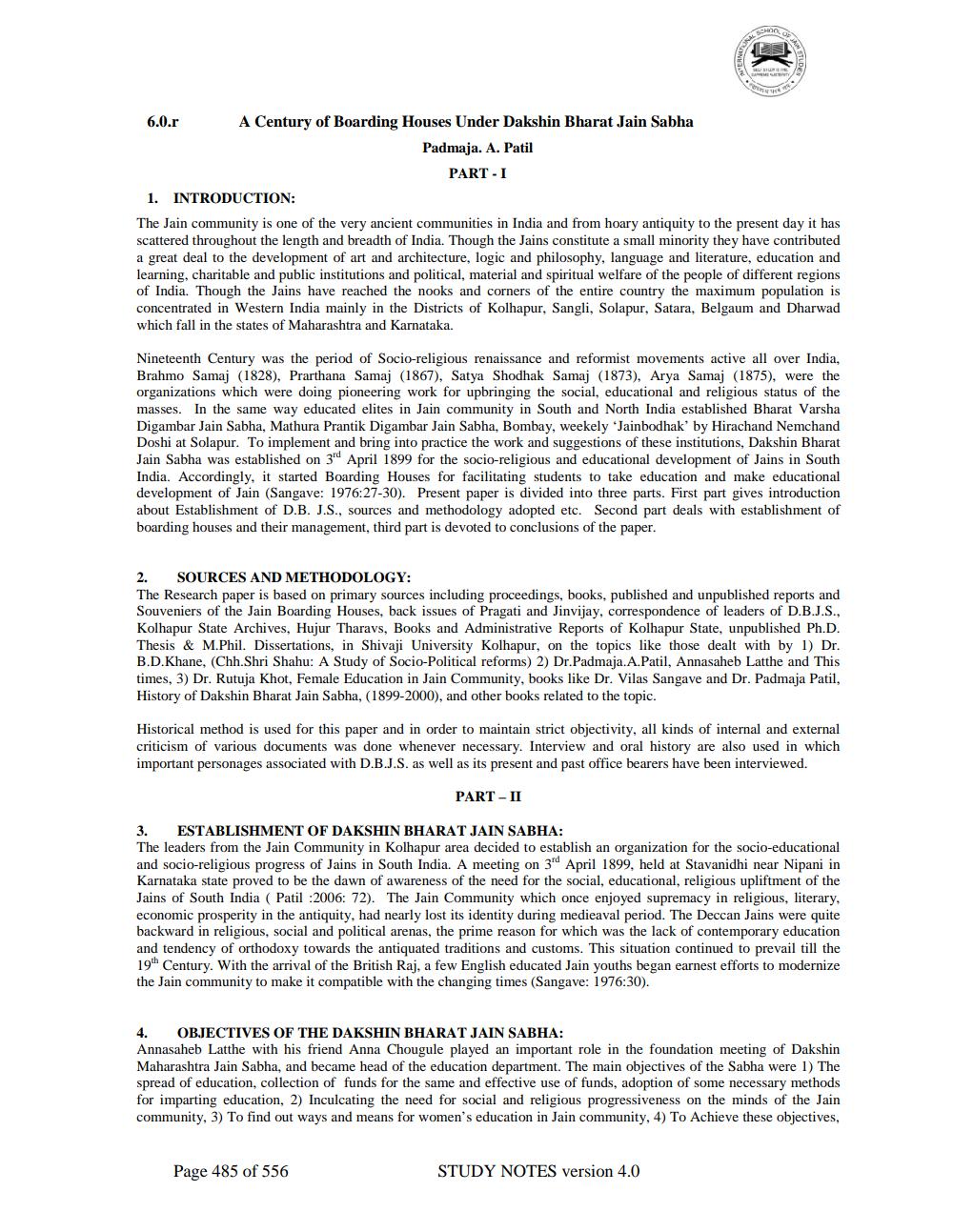________________
6.0.r A Century of Boarding Houses Under Dakshin Bharat Jain Sabha
Padmaja. A. Patil
PART-I 1. INTRODUCTION: The Jain community is one of the very ancient communities in India and from hoary antiquity to the present day it has scattered throughout the length and breadth of India. Though the Jains constitute a small minority they have contributed a great deal to the development of art and architecture, logic and philosophy, language and literature, education and learning, charitable and public institutions and political, material and spiritual welfare of the people of different regions of India. Though the Jains have reached the nooks and corners of the entire country the maximum population is concentrated in Western India mainly in the Districts of Kolhapur, Sangli, Solapur, Satara, Belgaum and Dharwad which fall in the states of Maharashtra and Karnataka.
Nineteenth Century was the period of Socio-religious renaissance and reformist movements active all over India, Brahmo Samaj (1828), Prarthana Samaj (1867), Satya Shodhak Samaj (1873), Arya Samaj (1875), were the organizations which were doing pioneering work for upbringing the social, educational and religious status of the masses. In the same way educated elites in Jain community in South and North India established Bharat Varsha Digambar Jain Sabha, Mathura Prantik Digambar Jain Sabha, Bombay, weekely Jainbodhak' by Hirachand Nemchand Doshi at Solapur. To implement and bring into practice the work and suggestions of these institutions, Dakshin Bharat Jain Sabha was established on 3 April 1899 for the socio-religious and educational development of Jains in South India. Accordingly, it started Boarding Houses for facilitating students to take education and make educational development of Jain (Sangave: 1976:27-30). Present paper is divided into three parts. First part gives introduction about Establishment of D.B. J.S., sources and methodology adopted etc. Second part deals with establishment of boarding houses and their management, third part is devoted to conclusions of the paper.
2. SOURCES AND METHODOLOGY: The Research paper is based on primary sources including proceedings, books, published and unpublished reports and Souveniers of the Jain Boarding Houses, back issues of Pragati and Jinvijay, correspondence of leaders of D.B.J.S., Kolhapur State Archives, Hujur Tharavs, Books and Administrative Reports of Kolhapur State, unpublished Ph.D. Thesis & M.Phil. Dissertations, in Shivaji University Kolhapur, on the topics like those dealt with by 1) Dr. B.D.Khane, (Chh.Shri Shahu: A Study of Socio-Political reforms) 2) Dr.Padmaja. A.Patil, Annasaheb Latthe and This times, 3) Dr. Rutuja Khot, Female Education in Jain Community, books like Dr. Vilas Sangave and Dr. Padmaja Patil, History of Dakshin Bharat Jain Sabha, (1899-2000), and other books related to the topic.
Historical method is used for this paper and in order to maintain strict objectivity, all kinds of internal and external criticism of various documents was done whenever necessary. Interview and oral history are also used in which important personages associated with D.B.J.S. as well as its present and past office bearers have been interviewed.
PART-II
3. ESTABLISHMENT OF DAKSHIN BHARAT JAIN SABHA: The leaders from the Jain Community in Kolhapur area decided to establish an organization for the socio-educational and socio-religious progress of Jains in South India. A meeting on 3rd April 1899, held at Stavanidhi near Nipani in Karnataka state proved to be the dawn of awareness of the need for the social, educational, religious upliftment of the Jains of South India ( Patil :2006: 72). The Jain Community which once enjoyed supremacy in religious, literary, economic prosperity in the antiquity, had nearly lost its identity during medieaval period. The Deccan Jains were quite backward in religious, social and political arenas, the prime reason for which was the lack of contemporary education and tendency of orthodoxy towards the antiquated traditions and customs. This situation continued to prevail till the 19 Century. With the arrival of the British Raj, a few English educated Jain youths began earnest efforts to modernize the Jain community to make it compatible with the changing times (Sangave: 1976:30).
OBJECTIVES OF THE DAKSHIN BHARAT JAIN SABHA: Annasaheb Latthe with his friend Anna Chougule played an important role in the foundation meeting of Dakshin Maharashtra Jain Sabha, and became head of the education department. The main objectives of the Sabha were 1) The spread of education, collection of funds for the same and effective use of funds, adoption of some necessary methods for imparting education, 2) Inculcating the need for social and religious progressiveness on the minds of the Jain community, 3) To find out ways and means for women's education in Jain community, 4) To Achieve these objectives,
Page 485 of 556
STUDY NOTES version 4.0




